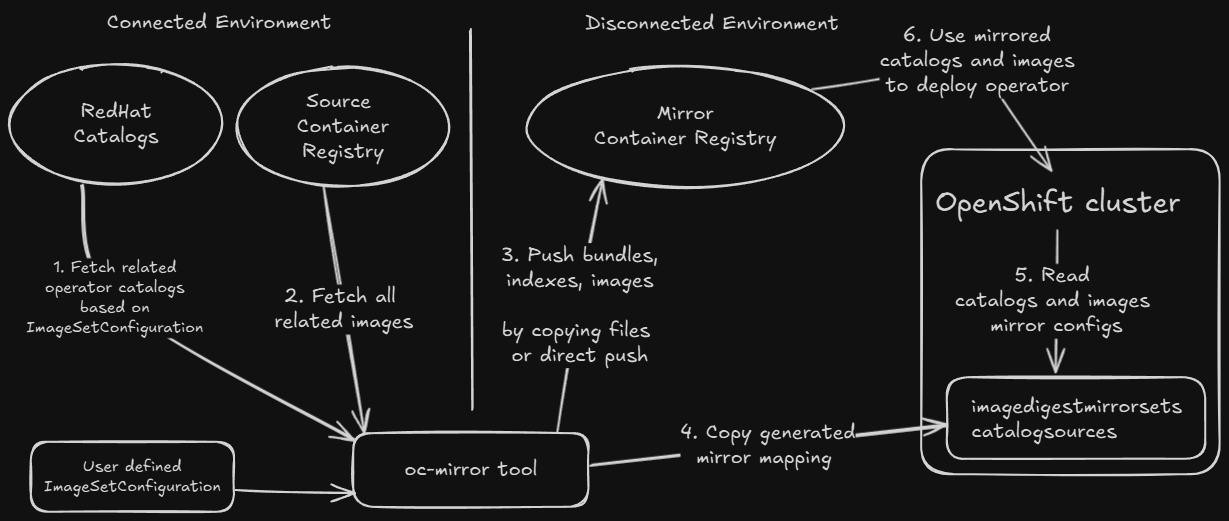Air-gapped Installation Guide for Openshift Environments#
This guide explains how to install the AMD GPU Operator in an air-gapped environment where the Openshift cluster has no external network connectivity.
Prerequisites#
OpenShift 4.16+
Assume users have followed OpenShift Official Documentation to install the air-gapped cluster and setup a Mirror Registry in Air-gapped environment.

Note
In general users action item is only to provide the
ImageSetConfigurationto configure the operator catalogs and images for mirroring the artifacts in the mirror container registry.Users may need to take extra step to manually copy mirrored artifacts to air-gapped system, in case the jump host is not allowed to directly push image to the mirror container registry.
Most of the steps described in the graph above is automatically completed by the
oc-mirrorand other RedHat provided tool, which can be downloaded from OpenShift official website.
Here is an example of AMD GPU Operator required ImageSetConfiguration for users to mirror required catalogs and images into their mirror registry.
Warning
The following
ImageSetConfigurationfile is just an example and it is incomplete.Users need to configure the
storageConfigpart, for directly pushing artifacts to the mirror container registry or saving into local file storage.Users may merge the
mirrorpart of this example file with their ownImageSetConfiguration.The detailed explanation of
ImageSetConfigurationcan be found from OpenShift official documentation.
kind: ImageSetConfiguration
apiVersion: mirror.openshift.io/v1alpha2
storageConfig:
# Configured by users
# option 1: directly mirrored images into your mirror registry
#registry:
# imageURL: <your mirror registry URL>/oc-mirror
# option 2: save all mirrored images into local filesystem
#local:
# path: /path/to/local
mirror:
# in this file we use 4.19 as an example
# please adjust the OpenShift version if needed
platform:
graph: true
channels:
- name: stable-4.19
type: ocp
operators:
- catalog: registry.redhat.io/redhat/redhat-operator-index:v4.19
packages:
# Node Feature Discovery (NFD)
- name: nfd
minVersion: "4.19.0-202509300824" # adjust the version if needed
channels:
- name: stable
# Kernel Module Management (KMM)
- name: kernel-module-management
minVersion: "2.4.1" # adjust the version if needed
channels:
- name: stable
- name: release-2.4
# AMD GPU Operator (Certified)
# To get full list of released version
# Either go to OperatorHub
# Or check https://github.com/redhat-openshift-ecosystem/certified-operators/tree/main/operators/amd-gpu-operator
- catalog: registry.redhat.io/redhat/certified-operator-index:v4.19
packages:
- name: amd-gpu-operator
minVersion: "1.3.2" # adjust the version if needed
channels:
- name: alpha
# adjust the image tag if needed
additionalImages:
- name: registry.redhat.io/ubi9/ubi:latest
- name: docker.io/rocm/gpu-operator:v1.3.1
- name: docker.io/rocm/gpu-operator-utils:v1.3.1
- name: docker.io/library/busybox:1.36
- name: docker.io/rocm/device-metrics-exporter:v1.3.1
- name: docker.io/rocm/test-runner:v1.3.1
- name: docker.io/rocm/device-config-manager:v1.3.1
- name: docker.io/rocm/rocm-terminal:latest
- name: docker.io/rocm/k8s-device-plugin:latest
- name: docker.io/rocm/k8s-node-labeller:latest
helm: {}
After mirroring setup, assume users installed NFD, KMM and enabled internal image registry in air-gapped cluster, see OpenShift OLM Installation for details.
Users installed AMD GPU Operator in Air-gapped cluster without creating DeviceConfig.
Installation Steps#
1. Build precompiled driver image#
Please build the pre-compiled driver image in the build cluster that has Internet access by following Preparing Pre-compiled Driver Images and follow the steps for OpenShift section.
After successfully pushing the driver image, save it by running:
If you are using OpenShift internal registry
podman login -u deployer -p $(oc create token deployer) image-registry.openshift-image-registry.svc:5000
podman pull image-registry.openshift-image-registry.svc:5000/default/amdgpu_kmod:coreos-9.6-5.14.0-570.45.1.el9_6.x86_64-7.0
podman save image-registry.openshift-image-registry.svc:5000/default/amdgpu_kmod:coreos-9.6-5.14.0-570.45.1.el9_6.x86_64-7.0 -o driver-image.tar
If you are using other image registry
podman login -u username -p password/token registry.example.com
podman pull registry.example.com/amdgpu_kmod:coreos-9.6-5.14.0-570.45.1.el9_6.x86_64-7.0
podman save registry.example.com/amdgpu_kmod:coreos-9.6-5.14.0-570.45.1.el9_6.x86_64-7.0 -o driver-image.tar
2. Import pre-compiled driver image#
A. Import images
Note
This step is for using the pre-compiled driver image within the cOpenShift internal registry (this is the OpenShift built-in image registry, not the mirror registry for Air-gapped installation).
For users who already push the pre-compiled driver image to other registry, they don’t have to manually load it in internal registry, just skip to step 3 to specify the image URL in
spec.driver.image.
Import pre-compiled driver image
After copying the image files to the air-gapped cluster, please switch to the air-gapped cluster and use podman to load the image, re-tag if needed then push the image to desired image registry:
Load the image file:
podman load -i driver-image.tarRe-tag if needed
podman tag <old tag> <new tag>, remember to tag the image to the gpu operator’s namespace, e.g. if you are using gpu operator inopenshift-amd-gpu, please tag the image toimage-registry.openshift-image-registry.svc:5000/openshift-amd-gpu/amdgpu_kmod.Use podman to login to the image registry if needed, for OpenShift internal registry:
podman login -u builder -p $(oc create token builder) image-registry.openshift-image-registry.svc:5000
Push the image:
podman push <new tag>
B. Once imported, verify that the required images are located in the internal registry.
For example, if you are using internal registry:
$ oc get is -n openshift-amd-gpu
NAME IMAGE REPOSITORY TAGS UPDATED
amdgpu_kmod image-registry.openshift-image-registry.svc:5000/openshift-amd-gpu/amdgpu_kmod coreos-9.6-5.14.0-570.19.1.el9_6.x86_64-6.4.1 3 days ago
3. Deployment of DeviceConfig in air-gapped environment#
A. Once all the required images and the precompiled driver are present in the internal registry we can now deploy the modified DeviceConfig. Note: the image variables are pointing to the internal registry instead the external ROCm repository.
apiVersion: amd.com/v1alpha1
kind: DeviceConfig
metadata:
name: test-deviceconfig
namespace: openshift-amd-gpu
spec:
driver:
# 1. specify image here if you are NOT using OpenShift internal registry
# 2. specify the image without tag
#image: registry.example.com/amdgpu_kmod
enable: true
version: "7.0"
devicePlugin:
enableNodeLabeller: true
metricsExporter:
enable: true
selector:
feature.node.kubernetes.io/amd-gpu: "true"